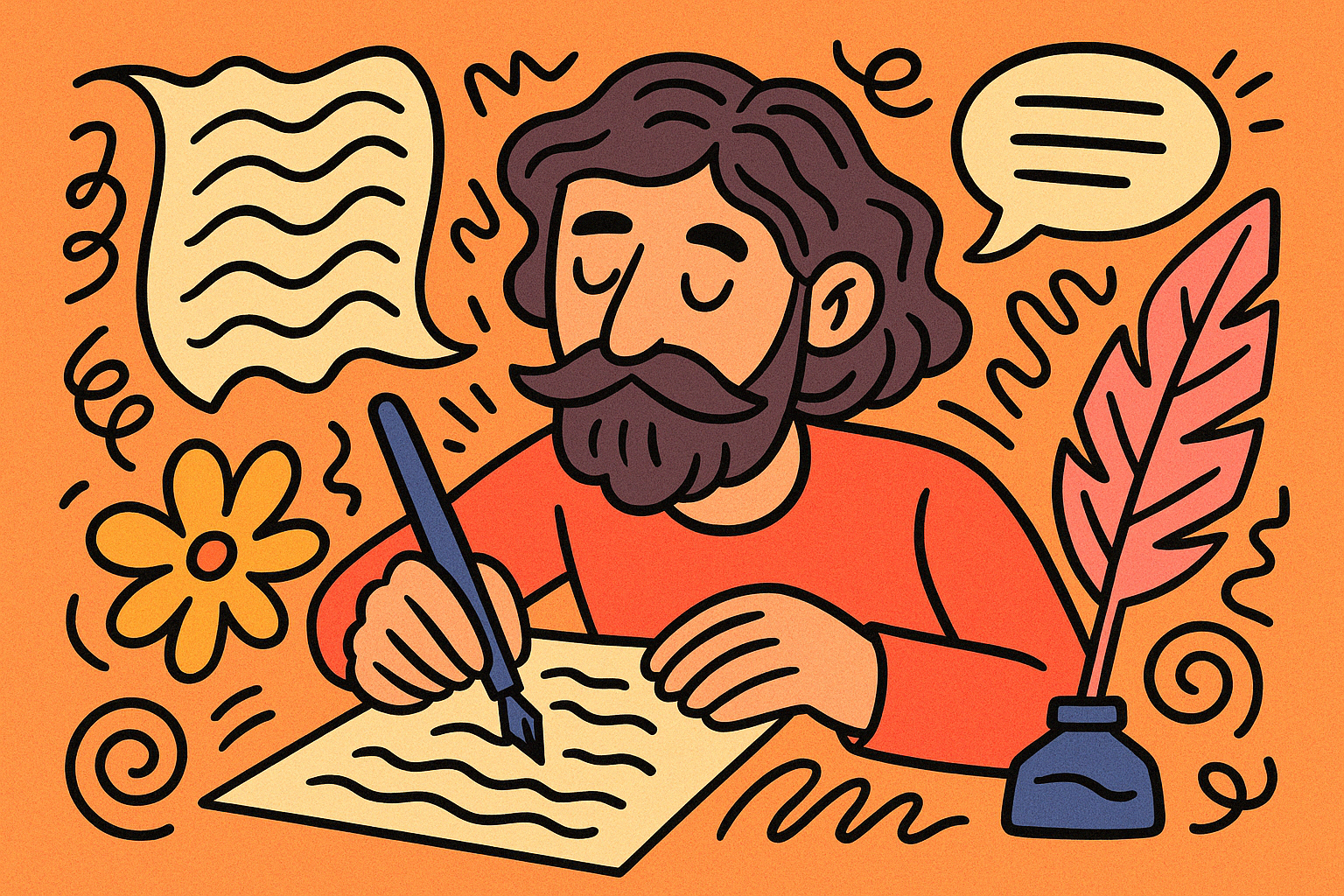The Beauty Of Free Verse Poetry

So here’s the thing—when most people hear free verse, they assume it’s poetry that’s just doing its own thing. Like, no rules, total chaos. But that’s such a beginner take, right?
If you’re reading this, I’m guessing you already know better. Free verse isn’t a mess—it’s just a different kind of order. It’s not rule-less, it’s just rule-rebellious.
I started digging into free verse for a writing project, and what I found really surprised me: the poets we call “free” are often more deliberate than their metrical counterparts.
They’re not leaning on form for rhythm or shape—they’re creating it from the ground up. That takes serious control.
This blog’s kind of my nerdy love letter to that idea.
I’m hoping to unpack what really makes free verse tick—not from a workshop 101 angle, but from the inside. The breath, the breaks, the tension. Let’s get into it.
How Free Verse Actually Works Under the Hood
Okay, let’s talk mechanics. Because the more I studied free verse, the more I realized how much is happening behind the scenes. It’s not just a stream of poetic consciousness.
There’s rhythm.
Structure.
Even a kind of internal logic.
It just doesn’t look like the old rules.
Rhythm Without Meter
First off—rhythm in free verse isn’t random, it’s just not regular. Think about the way Walt Whitman handles cadence in Leaves of Grass. His lines are shaped by breath, not by iambs.
That sounds simple, but it’s actually genius.
He’s mapping natural speech patterns onto poetic lines. Not to mimic speech, but to elevate it. The tension between spoken language and poetic intensity creates this almost mythic tone. And it’s all rhythm. No meter.
You see the same thing in someone like Louise Glück, who can land an emotional punch with just a pause.
Her enjambments feel like cliffhangers—strategic breaks that speed you up or slow you down, totally controlling how you experience the poem.
That’s rhythmic manipulation, and it’s just as calculated as anything in formal verse.
The Power of Syntax
Syntax is where things get really wild. In free verse, the sentence becomes the unit of rhythm as much as the line does.
The poet’s juggling both at once—phrasing, pacing, tension, and release. I kept coming back to Jorie Graham when researching this.
Her lines fracture across pages, but the syntax keeps pulling you forward. She uses grammar like a fishing line—taut, pulling you into the next phrase, the next breath.
And the thing is, you can’t pull that off unless you deeply understand how syntax works. It’s not just fancy fragmentation—it’s structure by stealth. You’re shaping the emotional and narrative arc within the sentence, not on top of it.
Line Breaks That Mean Something
I can’t stress this enough: line breaks aren’t just visual—they’re semantic tools. I used to think a good line break just added suspense or rhythm, but it’s more than that. A well-placed break can shift meaning, interrupt thought, or even create double meanings.
Take Ocean Vuong. In Night Sky With Exit Wounds, he breaks lines mid-image, mid-sentence, mid-emotion—and that break becomes the moment the image turns. The line ending holds emotional weight, and the continuation flips or deepens it. That’s not accidental. That’s design.
Visual Form = Emotional Form
The white space matters. I mean, look at how Claudia Rankine arranges her lines in Citizen. The chunked prose blocks, the dropped lines—it’s not just aesthetic. It is the emotion.
It mirrors fragmentation, stress, imbalance. In free verse, the poem’s shape on the page isn’t just decoration—it’s part of how the poem is telling the truth.
So yeah, free verse isn’t structure-less. It’s just a different kind of structure—less like architecture, more like choreography. There’s movement, breath, gesture. It’s a dynamic form, and it rewards deep attention.
Up next, we’ll zoom in on what makes a free verse poem work—like, really work. I’ll break down some of the qualities that separate “meh” from “mastery.”
Let’s keep geeking out.
What Great Free Verse Poets Always Get Right
I’ve gotta say—once I started breaking down what separates a “solid” free verse poem from one that hits you right in the gut (or brain, or both), the patterns became really clear. It’s not about mimicry or chasing a vibe—it’s about craft. And yeah, there is a craft to free verse, even if it doesn’t wear a metrical corset.
Here are six hallmarks I kept seeing in truly masterful free verse. Not every poem nails them all, but the greats hit at least a few, and when they do, it’s like poetry without a net—fluid, but razor-sharp.
1. Intentional Line Breaks
This is the big one. Line breaks in free verse carry meaning—emotional, rhythmic, even syntactic. They’re not just pauses. They’re hinges.
Let’s look at a quick example. In Tracy K. Smith’s Life on Mars, there’s a moment where a line ends with “The earth is blue…” and the next line completes it with “…in any color.” That break? Genius. The pause invites contemplation, then the continuation undercuts it. One line holds beauty, the next complicates it.
Great line breaks can:
- Delay resolution to build tension.
- Break up syntactical units to force re-reading.
- Emphasize a single word or phrase.
- Invite dual meanings (the line before vs. after the break).
Nothing in a great free verse poem “just lands there.” It’s all choice, not chance.
2. Internal Cohesion
You’d think that abandoning traditional form would make cohesion harder—and yeah, it does. But great free verse poems still feel whole. That cohesion isn’t driven by rhyme scheme or stanza structure—it’s built from within.
Sometimes it’s a sonic thread: echoes of a word, a vowel sound repeated with subtlety. Other times it’s thematic: circular imagery, or a return to a question the poem began with. Jericho Brown does this incredibly well—he’ll weave a line from earlier back into the end, slightly altered, like a ribbon looped back on itself.
Unity isn’t about symmetry—it’s about resonance.
Free verse doesn’t need a formal “frame,” but it absolutely needs an internal system of echoes, tensions, and returns to hold it together.
3. Organic Imagery
Here’s where things get really personal. In free verse, imagery can’t be ornamental—it has to feel earned. Great poems don’t just use images; they’re driven by them.
When I read Carl Phillips, for instance, I’m floored by how his metaphors emerge organically from the speaker’s state of mind. They don’t feel pasted in for effect. They grow out of the emotional terrain. Same with Aracelis Girmay—her images often feel like the most natural way to express something ineffable.
So what’s the takeaway? If the image doesn’t feel inevitable, it doesn’t belong. The best images in free verse are born from the pressure of the line, the voice, the moment. Not pulled from a poetic Rolodex.
4. Sonic Play
Yes, free verse can still rhyme—just not always at the end of a line. And it doesn’t have to. But sound is still king.
I think of it like this: formal verse inherits its music; free verse has to build it. Assonance, consonance, subtle internal rhyme, repetition, alliteration—these are the tools. But they’re not decoration. They’re glue. They bind the lines together when structure doesn’t.
Take this line from Elizabeth Bishop:
“The art of losing isn’t hard to master…”
It’s in a villanelle, sure, but imagine it in free verse—what makes it so sticky is sound. The repetition, the s/z interplay, the rhythm of the stress pattern. That kind of sonic architecture? Totally fair game in free verse—and when it’s used well, it gives the poem texture and depth without needing meter as scaffolding.
5. Controlled Disruption
Disruption is everywhere in great free verse. Syntax breaks down. Thoughts split mid-sentence. Forms mutate. But here’s the key: the chaos is curated.
This one hit me hardest reading Anne Carson. She might toss in a fragment, an untranslated Greek line, a jump cut from ancient myth to a modern subway platform—and yet, it works. Why? Because she knows exactly when to let the structure falter.
Controlled disruption can:
- Mirror emotional fracture.
- Reflect instability of thought or memory.
- Undermine reader expectations (in a good way).
- Let the silence say something.
Free verse lets the poet play with fragmentation—but the greats know how to wield it like a scalpel, not a hammer.
6. Tonal Precision
Finally, the voice. In free verse, tone has to carry more weight because there’s no form to lean on. Every line has to sound like it belongs—not just to the poem, but to the voice inside it.
What gets me about poets like Danez Smith is their tonal clarity. They can be raw, tender, furious, irreverent—and it never feels off-key. The tone matches the subject matter perfectly, but never in a predictable way.
Whether it’s a whisper or a shout, a joke or a sob, the tone in great free verse is precise as hell. There’s no “default poetic voice.” Every word, every phrase, is calibrated.
All these hallmarks?
They’re choices. They’re what separate free verse from free fall. And once you start seeing them in play, it’s hard not to get obsessed.
Okay—so who’s really doing this well? Let’s jump into the poets who took free verse and ran with it.
Poets Who Rewrote the Free Verse Playbook
There’s free verse—and then there’s free verse that changes the game. Some poets didn’t just write in free verse; they reshaped what it could be. When I was digging into this topic, these five kept coming up not just as practitioners, but as innovators. Let’s take a closer look at how each one made the form their own.
Walt Whitman – The Breathline Pioneer
Whitman’s not just the “father of free verse”—he’s the guy who showed that you could build a poem around the breath. In Leaves of Grass, his long, flowing lines weren’t just stylistic. They were physical. They matched human speech, human lungs, human movement.
Key innovations:
- Breath-length lines: let syntax drive the form, not meter.
- Cataloging as rhythm: lists, repetition, anaphora for momentum.
- Democratic voice: expansive, inclusive, populist tone.
He made the poem a body—living, breathing, moving—and opened the floodgates for modern free verse.
T.S. Eliot – Fragmentation and Formal Ruin
If Whitman gave us the body, Eliot gave us the fracture. In The Waste Land, he shatters linearity, continuity, and coherence—and somehow, it’s still a poem. It’s still music.
Key innovations:
- Juxtaposition: voice, time, image layered in shards.
- Dislocation as structure: using fragmentation to mirror cultural and emotional disarray.
- Allusion overload: layering meaning through references, not exposition.
Eliot didn’t just embrace disorder—he made it architectural. And poets have been riffing on that ever since.
H.D. (Hilda Doolittle) – Precision Over Ornament
H.D.’s free verse is clean. Minimal. Every word matters. As one of the Imagists, she brought extreme focus and restraint into a form that often trends expansive.
Key innovations:
- Imagist economy: distilled imagery, zero filler.
- Controlled tone: restraint creates intensity.
- Spatial design: line breaks as sculptural space.
Her poem Oread is six lines and hits harder than most 60-line poems. That’s the power of compression in free verse.
Adrienne Rich – Political Voice Through Formal Resistance
Rich’s early work was formal, but she broke free—and her later poetry shows how abandoning form can be an act of rebellion. Free verse let her write with urgency, honesty, and fury.
Key innovations:
- Feminist form-breaking: resisting patriarchal traditions through structure.
- Narrative fragmentation: disjointed form mirrors systemic rupture.
- Ethical clarity: poetry as political testimony.
She used free verse as both a stylistic and political choice. The line break became a place of resistance.
Ocean Vuong – Prose, Memory, and Intimacy
Vuong takes free verse to incredibly intimate places. His lines are soft-spoken but loaded. He blends lyric and narrative, memory and image, in a way that feels both ancient and completely new.
Key innovations:
- Hybrid forms: prose-poem textures inside verse.
- Emotional enjambment: lines that fall apart emotionally mid-thought.
- Tender compression: huge feelings in tiny spaces.
In On Earth We’re Briefly Gorgeous, his poetry feels like a letter, a spell, a confession. Every line earns its place by not sounding like poetry—and yet it’s the most poetic thing.
What unites all of these poets?
They didn’t just write outside the rules—they rewrote what the rules could be. They found freedom within the chaos, not in escape from it.
And the form is still growing. Still mutating. That’s the beauty of free verse—it’s not a style. It’s a conversation, still unfolding.
Want to keep talking about this?
I’d love to know your favorite free verse moves or lines that totally changed how you see the form. Let’s trade notes.





